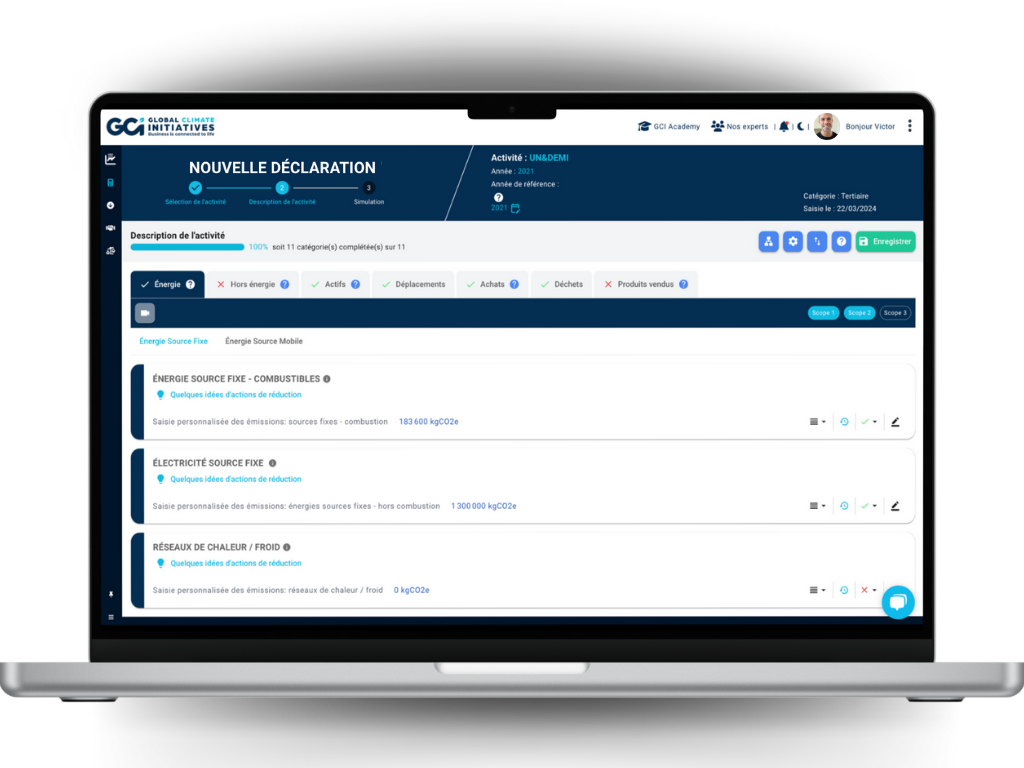Carbon Competitiveness
"The upstream carbon of one is always the downstream carbon of the other"
This statement highlights the importance of the "carbon weight of purchasing" : in fact, it represents between 40 and 80% of the carbon footprint of companies and organizations.
Carbon Competitiveness® is the ability to demonstrate, for the same quality of service or product production, a lower GHG emission than its competitors.
This recent concept is a direct consequence of customers' new demand for decarbonization of their purchases.

Everyone has become concerned about reducing their own carbon footprint, both in terms of new fiscal and regulatory constraints and in commercial terms, and this Carbon Competitiveness® is also being imposed on them, particularly in calls for tender.
On the other hand, ignoring it means taking the risk of seeing your competitors distinguish themselves on this subject, which has become an additional criterion for market selection.
This is a new component of every company's strategy.
It is up to each company to find the balance between reducing greenhouse gas emissions, which is a commercial advantage, and the economic imperatives of traditional competitiveness, including the selling price.
The new imperative is therefore for the company todisplay emission factors for its products and services that are lower than those of its competitors, all calculated fairly and with rigor and compliance.
OnlyISO 14 067 precisely defines the methods of calculation and control of the results that are opposable to third parties for the calculation of these factors called PCF (Product Carbon Footprint)


The large share of purchasing in its carbon footprint provides a great opportunity to engage with its own suppliers and customers in a new type of collaboration: the virtuous circle of low-carbon.
The Carbon Competitiveness® of companies depends on those of their suppliers, conditions that of their customers, and generates benefits for all:
- A virtuous dynamic that allows for a lasting relationship of progress and shared benefits between the parties.
- The promise of accelerating a solid low-carbon trajectory, because it involves all the players, is beneficial for everyone, and is essential for our common fight against climate change.
Carbon Competitiveness®, Climate, and Carbon Footprint®.
Carbon Competitiveness® has become a major issue for the sustainability of companies, and a formidable lever for the imperative drastic reduction of GHG emissions on our Planet.
Each company must be able to display its FCP to its customers and use it as a sales argument. Many buyers are increasingly sensitive to this.
In order to make a successful transition to a low-emission economy, the first step is to carry out a complete and compliant BilanCarbone®.
This implementation of a quantitative and qualitative analysis of the company's incoming and outgoing "Carbon" flows allows both :
Detect and implement solutions to reduce its emissions depending on its own organizational and process choices.
To decide on a positive carbon discrimination® of its various suppliers, synonymous with their quality and durability, their Carbon Competitiveness®.
Define and manage your decarbonation strategy to maintain your Carbon Competitiveness®.
To remain competitive, a company must regularly calculate its GHG inventory®, in full compliance, and as accurately as possible, and thus detect, implement and manage its emission reduction solutions.
Have a solid methodological base
Emissions factors are used to convert activity or process data into a global carbon footprint.
These factors are therefore the "carbon weight" of a product or service.
There are 4 types of emission factors
Monetary EFs
Monetary emission factors : these factors are proposed by ADEME and other international reference bases, and are applicable to Scope 3 emissions.
They considerably simplify the work of entering the GHG balance, but have many disadvantages. Indeed, by using these factors, the company must reveal accounting information to carry out its GHG assessment.
These factors are also not very significant, as the emissions calculated depend on the prices at which the company has negotiated its energy, goods and services purchases.
ADEME gives an uncertainty of 80% for these factors and recommends using them only as a last resort.
FE by type of products and services
Emission factors by type of products and services: these factors are also proposed by ADEME and other international reference bases.
These are average factors. For example, a T-shirt, which has only one emissions factor in the base, may be produced in Asia or Europe using different processes, materials and energy, which means that the quantity of GHG emissions associated with it varies considerably.
Moreover, not all goods and services are covered by these factors (only 7,000 factors in the Ademe's Base Carbone®, for hundreds of millions of products and services on the market).
They can be used to make a first GHG emissions assessment, but should be replaced as soon as possible by more realistic emission factors described below.
FE composites®.
Composite Emission Factors® (Product Carbon Footprint, PCF, calculated according to ISO 14 067): these factors are developed from the detailed composition of a product or service, and allow the GHG emissions associated with each stage of its life cycle to be taken into account (extraction and transport of raw materials, manufacturing processes, distribution from the factory, use and end of life of the product).
EF per unit of work
Emissions Factors per Work Unit (EFWU): these factors are calculated on the basis of the overall carbon impact of an organization or part of its activity, by allocating its GHG emissions to its production units. They make it possible to take precise account of the various stages in the life cycle.
PCFs and emission factors per unit of work are thus indispensable tools for companies wishing to improve their Carbon Competitiveness® and will make them prefer suppliers with the best "carbon" performance.
Measuring and improving its Carbon Competitiveness
The highlighting of suppliers with the best Carbon Competitiveness®, the Carbon Positive Discrimination®, can be done through internal or external "Market Place", where product catalogs are integrated with their "carbon weight", PCF calculated according to ISO 14 067.
It is therefore necessary for buyers to be able to verify the value communicated by the supplier, which has become a discriminating factor in purchasing, by analyzing it accordingly with all the necessary fairness: application of the ISO 14 067 standard, direct access or through a trusted third party to the PCF qualification form tracing all the items and the quality/compliance of the emission factors taken into account, and congruence of the quantitative data affected.
The Global Climate Initiatives (GCI ) platform ensures the production and availability/confidentiality of these forms; it can audit them if requested, or send this request to a trusted third party chosen by the parties who will certify the correct application of the ISO 14 067 standard and quality of the primary data taken into account.

This first step in the decarbonization process of purchases is therefore simply to discriminate between the offers received according to the unit carbon weight per product or service.
Beyond that, it will be interesting to collaborate with suppliers to obtain increasingly detailed information and to find ways to improve together, which is an essential condition for continuously improving one's own Carbon Competitiveness® compared to one's competitors.
Regulation: ensuring fairness
Various regulations and standards must be respected in order to be able to seriously attest to the reduction of its carbon footprint, and to publish a GHG inventory® or Bilan des émissions GES (GHG emissions assessment), which can be used against third parties.
GHG inventory® method in France.
Reporting according to ISO 14 064 or GHG Protocol internationally.
Reference databases: Ademe's Empreinte® database, Inies®, Ecoinvent®, Beis-Defra®, Iata, Glec, etc.
Similarly, it is essential to ensure fairness in the positive carbon discrimination® of suppliers with respect to the emission factors of the products and services they offer.
It is imperative to verify the proper use of the ISO 14 067 standard to perform these composite emission factor® calculations, and the possibility to audit these calculations directly or indirectly
